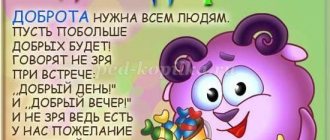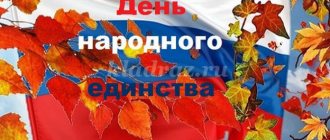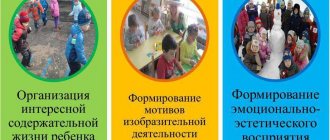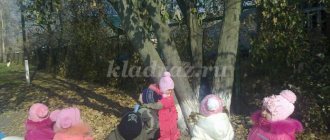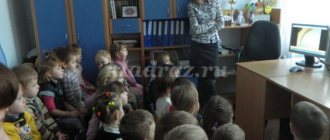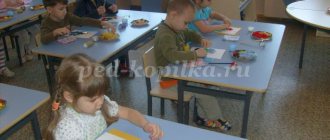Project "Creative Workshop"
PROJECT PASSPORT
"CREATIVE WORKSHOP"
(for children of senior preschool age 5-6 years)
Project problem.
Today, in preschool, the problem of organizing children's activities in understanding the world around them - research and experimentation - has not been sufficiently developed. This activity equally influences the development of the child’s personality as well as gaming. Ideally, the presence of these two truly children's activities is a favorable condition for the comprehensive development of preschoolers.
The child is presented with ready-made truths, ready-made conclusions and generalizations. Instead of creating the conditions to examine, experiment, create, get some result yourself. The child is forced to receive ready-made information about how other people learned about the world and what they once learned about the object being studied. Such passive perception of information about the world around us does not make it possible for children to develop high cognitive activity. This can lead to the fact that it will be difficult for children to independently acquire knowledge and study.
Relevance of the project.
Experimentation gives children real ideas about the various aspects of the object being studied, about its relationships with other objects and with the environment. By experimenting, the child hears, sees and does everything himself, so new knowledge is acquired firmly and for a long time. A Chinese proverb says: “Tell me and I will forget, show me and I will remember, let me try and I will understand.” The more varied and intensively a child experiments, the more new information he receives, the faster and more fully he develops. At the same time, the child’s memory is enriched, his attention, thinking, and imagination are activated. The need to talk about what you saw develops speech. It is impossible not to note the positive impact of experiments on the emotional sphere of the child, on the development of creative abilities, on the formation of work skills and the promotion of health. You can study plants, animals, humans, and inanimate objects. In most cases, this does not require any special equipment.
The child’s need for new impressions underlies the emergence and development of inexhaustible orienting (search) activity aimed at understanding the world around him. The more varied and intense the search activity, the more new information the child receives, the faster and more fully he develops.
Organization of project activities with preschoolers, through cultural practices, one of the types of which is the cognitive and research activity of children, with the help of which they learn about the world around them. Observing demonstrations of experiments and practicing their reproduction allows children to become discoverers and explorers of the world that surrounds them. Preschoolers are characterized by an orientation towards understanding the world around them and experimenting with objects and phenomena of reality. Experiments carried out independently by children contribute to the creation of a model of the phenomenon being studied and the generalization of the results obtained effectively. They create conditions for the opportunity to draw independent conclusions about the value significance of physical phenomena for a person and himself.
Objective of the project.
Organization of cultural practices for older preschoolers stimulating
manifestation of curiosity, willingness to experiment, and the ability to combine knowledge obtained from different sources.
Project objectives:
- expand children’s ideas about the world around them through acquaintance with
basic knowledge from various fields of science;
- develop the ability to observe, analyze, compare, identify characteristic, essential features of objects and phenomena, and generalize them based on these features;
— to form ways of cognition in preschoolers through sensory analysis;
— involve parents in children’s experimental research activities;
- develop an emotional and value-based attitude towards the nature of the native land.
Project type:
cognitive-research.
Project type:
group.
Project participants:
older children, teachers, parents.
Implementation timeframe:
short-term (one week).
Predicted result.
Organizing the cultural practices of older preschoolers in experimental activities will arouse children’s interest in exploring nature and the surrounding world, develop mental operations (analysis, synthesis, classification, generalization, etc.), stimulate the child’s cognitive activity and curiosity, activate the perception of educational material on familiarization with natural phenomena, with the basics of mathematical knowledge, with the ethical rules of life in society.
Children will develop observation and inquisitiveness of mind, a desire to understand the world, and the ability to use non-standard solutions in difficult situations;
In children's speech, their vocabulary will be enriched with various terms, and the ability to construct their answers to questions grammatically correctly will be consolidated. Children’s ability to ask questions, follow the logic of their statements, and construct evidence-based speech is improved;
The interaction of children with peers and adult project participants will stimulate the emergence of initiative, independence, the ability to cooperate with others, the need to defend their point of view, coordinate it with others, etc.
Material and technical resources required to complete the project:
- assistant instruments: magnifying glass, cup scales, hourglass, various magnets, binoculars;
- transparent and opaque vessels of different configurations and different volumes: plastic bottles, glasses, ladles, buckets, funnels;
- natural materials: pebbles of different colors and shapes, minerals, clay, earth of different compositions, coal, coarse and fine sand, bird feathers, shells, cones, nut shells, pieces of tree bark, leaves, twigs, fluff, moss, fruit seeds and vegetables;
- waste material: pieces of leather, foam rubber, fur, scraps of fabric, corks, wire, wooden, plastic, metal objects, molds - inserts from sets of chocolates;
— technical materials: nuts, screws, bolts, nails;
- different types of paper: regular landscape and notebook paper, tracing paper, sandpaper;
— dyes: watercolors;
— medical materials: pipettes, flasks, test tubes, spatulas. Wooden stick, cotton wool, beakers, funnels, syringes (plastic without needles), gauze, measuring spoons;
- other materials: mirrors, balloons, wooden toothpicks, vegetable oil, flour, salt, colored and transparent glass, molds, trays, stacks, rulers, sieve, basin, matches, threads. Buttons of different sizes, needles, pins, cocktail straws;
— gaming equipment: magnetic games “Fishing”. Clown, water mill, sand and water play bath;
— containers for storing bulk and small items;
- oilcloth aprons, towels.
Main section of the program:
social and communicative development
Organization of activities within the project.
Preparatory stage:
— formulation of the problem and goals of the project;
— study and analyze methodological literature on the topic of the project;
— planning children's experimental activities within the framework of the project;
— selection of basic equipment and material to equip the experimental activity center;
— selection of pictures and illustrations, diagrams;
— selection of presentations for viewing;
— introducing children and parents to the goals of the project and involving them in active participation in it.
Main stage:
- Conducting conversations with children about various properties of materials and natural phenomena;
— conducting experiments, didactic games, outdoor games;
- reading fiction, listening to entertaining stories;
— viewing presentations, cartoons;
— drawing up experimental schemes;
— drawing pictures on the topic of the project;
— consultation with parents on the topic: “The role of the family in the development of children’s research activities.
The final stage:
- holding an evening of entertainment - questions and answers: “Journey to a magical land.”
Project technological map
Social and communicative development
| Cultural practices | |
| Kinds | Content |
| Integration of cultural practices: — k.p. communicative, -k.p. knowledge of the world and self-knowledge, -k.p. formation of behavior and attitudes, -k.p. free children's activities. | Situational conversation: "How did you go to the hairdresser" Role-playing games "Journey to Treasure Island", "Barbershop", "Firemen to the Rescue", "Rescue Service" Work – wipe the cubes, wipe the leaves of the flowers, sprinkle the paths with sand |
Cognitive development
| Cultural practices | |
| Kinds | Content |
| Integration of cultural practices: - k.p. knowledge of the world and self-knowledge, — k.p. communicative, - k.p. free children's activities | Conversations: “What happened on the river in winter?” “Snow coat for all living things” (discuss with children the protective properties of snow). “How does frost form?”, “Can frost kill a tree?”, “Where is snow born?” “The World of Paper”, “With and without Water”, “Magnets, Magnetism”, “Magic Electricity”, “With and without Water” Watching a cartoon "Jess Mysteries" Observation : “Behind the wind and precipitation”, “Behind the buds on the trees”, “Determining the weather by signs,” Behind the snow cover” OED With water “Water and Paper”, “Paper, Fire, Water”, “Rustling and Singing”, “Freezing of Water”, “A poplar branch”, “What properties?”, “Transparent water”, “Helper water”, “Smart jackdaw”, “Where does water come from” With magnets “Dry from the water”, “We are magicians!”, “Unusual paper clip”, “Alpine skier”, “Attracted - not attracted”. With electricity “Magic Ball”, “Miracle Hairstyle”, “Wizards”. "How does a thermometer work?" With plants “Onion in a jar”, “Evaporation of moisture from plant leaves”, “Why does a butterfly look like a flower?” Di “Chameleon”, “Light, sound, water”, “We must say it differently”, “What did I say?”, “Go through the maze”, “Find a pair”, “Find the differences”. |
Speech development
| Cultural practices | |
| Kinds | Content |
| Integration of cultural practices: -k.p. knowledge of the world and self-knowledge, -k.p. game interaction, -k.p formation of behavior and attitude, -k.p. free children's activities, - k.p. communicative. | Reading A. Klykov “Underwater in winter” V. Berestov “Icy conditions” T. Nuzhdina “Miracle is Everywhere” (camel, giraffe, kangaroo, crocodiles, elephant, icicles). V. Esaulov “Arctic miracle” O. Gerasimova “The Tale of the Dispute of Fire, Water and Wind” Y. Bayanov “The Curious Sun” K. Chomov “The Trees Are Sleeping”, A. Kushner “What’s in the Pocket?” Puzzles about winter phenomena in nature: about ice, snow, frost, frost, hail, wind. Speech game "Erudites". |
Artistic and aesthetic development
| Cultural practices | |
| Kinds | Content |
| Integration of cultural practices: -k.p. knowledge of the world and self-knowledge, -k.p. formation of behavior and attitudes, -k.p. free children's activities, - k.p. communicative. | Cutting paper snowflakes. GCD Drawing "Icicles on the Roof" GCD Modeling on the “Droplets” plate Drawing at will based on observations. |
Physical development.
| Cultural practices | |
| Kinds | Content |
| Integration of cultural practices: -k.p. healthy lifestyle, -k.p. game interaction, -k.p. formation of behavior and attitudes, -k.p. free children's activities | Games: Ecological game "Scouts" P/I “Sun or Wind” (Chuvash folk game) Game "Earth, water, fire, air" M/n game “Cold - hot”, “Echo”, “The sea is agitated”, “Find an object with a magnetic property” |
Interaction with parents of students.
| Cultural practices | |
| Kinds | Content |
| Integration of cultural practices: - k.p. knowledge of the world and self-knowledge, — -k.p. formation of behavior and attitudes, - k.p. communicative | Involving parents in experimental activities. Consultation “The role of the family in the development of the child’s search and research activity” At home with the children, tell them where and how magnets help people. |
Distribution of activities by activity centers:
- "Lukomorye" - center for speech development:
place a selection of books, illustrations depicting various signs of the winter months (blizzards, blizzards, icicles), coloring books, stencils.
- “Researchers” is a center for educational and research activities:
place a variety of materials for educational and research activities: experiments with bulbs, flashlights for conducting experiments with the formation of shadows, didactic games, visual material.
- “Workshop” is
the center of constructive activity :
place a variety of constructors and diagrams. - “Aibolit” is the center of a role-playing game:
place a variety of attributes for role-playing games.
- “The Magic Palette” is a center for artistic and aesthetic development:
place albums, colored paper, paints, brushes, pencils, glue, plasticine for children’s artistic and productive activities.
- “Golden Key” is a center for musical theater activities:
place costumes and attributes for theatrical activities.
- “I, I know myself” is the center of socio-communicative development
place emotion games, a box of surprises, a screen and a chair for privacy.
- “Be always healthy!”
–
center and physical development:
place gaming materials and attributes, a variety of sports equipment that promote children’s motor activity.
Project implementation results (result)
During the project, children participated in research activities with interest; became acquainted with the properties of different types of objects through experiments; learned to draw conclusions, solve problematic problems, and make generalizations.
Children began to more actively show initiative, independence, and the ability to cooperate with others. We felt the need to defend our point of view and coordinate it with others.
Children's speech was enriched with various terms, their ability to ask grammatically correct questions and construct their answers, follow the logic of their statements, and construct demonstrative speech was improved.
During the project, parents were consulted and involved in joint experimental activities with children.
The result of the project was entertainment - an evening of questions and answers: “Journey to a magical land”
List of literature
(or links) to copyright, educational and methodological developments, programs, recommendations, manuals that ensure the implementation of the project, Internet resources:
1. Dybina O.V. The unknown is nearby (entertaining experiences and experiments for preschoolers). Moscow 2001
2. Kondratyeva N.N. "WE" Children's environmental education program. St. Petersburg 2000
3. Voronkevich O.A. Welcome to ecology St. Petersburg. 2003
4. Balatsenko L., Work with parents on environmental education of children // Child in kindergarten. 2002.
5. I.E. Kharchenko “Invigorating gymnastics for preschoolers” Childhood - Press, 2010. P.96
6. Arushanova, A. G. Speech and verbal communication of children 3-7 years old [Text]. M.: Mozaika-Sintez, 2008. 128 p.
7. Internet resources. https://nsportal.ru/detskiy-sad/raznoe/2015/02/01/kruzhok-tvorcheskaya-masterskaya
8. https://lesson-notes.rf/detsad/raznoe
9. https://www.pedkabinet.ru/blog/
10. https://nsportal.ru/detskiy-sad/okruzhayushchiy-mir/2013/01/07/kartoteka-opytov-i-eksperimentov-dlya-detey-doshkolnogo
11. https://ext.spb.ru/faq/2448-2013-03-02-20-53-23.html
12. https://www.maam.ru/detskijsad/opyty-i-yeksperimenty-dlja-starshego-doshkolnogo-vozrasta.html
Application to the project:
1. Consultation for parents: “The role of the family in the development of the child’s research activity”
2. Description of the experiments: “Transparent water”, “Why does everything sound?”
3. Logical tasks.
Annex 1.
Consultation for parents: “The role of the family in the development of the child’s search and research activity»
It is known that not a single educational or educational task can be successfully solved without fruitful contact with the family and complete mutual understanding between parents and teachers. And parents must realize that they are raising their children by their own example.
Every minute of communication with a child enriches him and shapes his personality.
In individual conversations and consultations through various types of visual propaganda, we convince parents of the need for daily attention to their children's joys and sorrows. How right are those who build their communication with the child as an “equal”, support the cognitive interest of children, their desire to learn new things, independently figure out the incomprehensible, the desire to delve into the essence of objects, phenomena, reality.
So that parents follow the wise advice of V.A. Sukhomlinsky: “Know how to open one thing to the child in the world around him, but open it in such a way that a piece of life sparkles in front of the children with all the colors of the rainbow.
Always leave something unsaid so that the child will want to return again and again to what he has learned.”
Here are some tips for parents on developing children’s research activity:
What not to do and what to do?
To maintain children's interest in cognitive experimentation.
You should not brush aside your child’s wishes, even if they seem impulsive to you. Indeed, these desires may be based on such an important quality as curiosity.
Encourage curiosity, which generates the need for new experiences: it generates the need for exploration.
You cannot refuse to participate in joint activities with your child, games, etc. – a child cannot develop in an environment where adults are indifferent to him.
Provide the child with the opportunity to act with different objects and materials, encourage experimentation with them, forming in children a motive associated with the internal desires to learn new things, because it is interesting and pleasant, to help him in this with your participation.
Momentary prohibitions without explanation hinder the child’s activity and independence.
If you have a need to prohibit something, be sure to explain why you are prohibiting it and help determine what is possible or how it is possible.
Do not endlessly point out the mistakes and shortcomings of the child’s activities. Awareness of one's failure leads to the loss of all interest in this type of activity.
From early childhood, encourage your child to complete the work he has started, emotionally evaluate his volitional efforts and activity. Your positive assessment is most important to him.
The impulsive behavior of a preschooler in combination with cognitive activity, as well as his inability to foresee the consequences of his actions, often leads to actions that we. Adults, we consider it a violation of rules and requirements. Is it so?
If the act is accompanied by the child’s positive emotions, initiative and ingenuity, and the goal is not to harm anyone, then this is not an offense, but a prank.
Showing interest in the child’s activities, talk with him about his intentions, goals (this will teach him goal setting), how to achieve the desired result (this will help him understand the process of activity). Ask about the results of the activity, how the child achieved them (he acquires the ability to formulate conclusions, reasoning and arguing.
“The best discovery is the one that a child makes himself!” (Ralph W. Emerson.)
Appendix 2.
Description of experiments.
1). "Why does everything sound"
Task:
lead children to understand the causes of sound: vibration of an object.
Material:
tambourine, glass beaker, newspaper, wooden ruler, metallophone.
Move:
Game “What does it sound like?” - the teacher invites the children to close their eyes, and he makes sounds using objects known to them. Children guess what it sounds like. Why do we hear these sounds? What is sound? Children are asked to imitate in their voice how a mosquito rings (z-z-z-z). How a fly buzzes (w-w-w). How does a bumblebee buzz? (oooh) Then each child is asked to touch the string of the instrument, listen to its sound and then touch the string with his palm to stop the sound. What happened? Why did the sound stop? The sound continues as long as the string vibrates. When she stops, the sound also disappears. Does a wooden ruler have a voice? Children are asked to make a sound using a ruler. We press one end to the table, and clap the free end with our palm. What happens to the ruler? (Trembles, hesitates). How to stop the sound? (Stop the ruler from oscillating). We extract sound from a glass glass using a stick and stop. When does sound arise? The sound occurs when air moves back and forth very quickly. This is called oscillation. Why does everything sound? What other objects can you name that will sound?
2). "Clear water"
Task:
identify the properties of water (transparent, odorless, pours, has weight).
Materials:
two opaque jars (one filled with water), a glass jar with a wide neck, spoons, a bowl of water, a tray, object pictures.
Progress:
Droplet came to visit. Who is Droplet? What does she like to play with? On the table, two opaque jars are closed with lids, one of them is filled with water. Children are asked to guess what is in these jars without opening them. Are they the same weight? Which one is easier? Which one is heavier? Why is it heavier? We open the jars: one is empty - therefore light, the other is filled with water. How did you guess that it was water? What color is it? What does the water smell like? An adult invites the children to fill a glass jar with water. To do this, they are offered a variety of containers to choose from. What is more convenient to pour? How to prevent water from spilling on the table? What are we doing? (Pour, pour water.) What does the water do? (Pours) Let's listen to how it pours. What sound do we hear? When the jar is filled with water, children are invited to play the game “Recognize and Name” (looking at pictures through the jar). What did you see? Why is the picture so clear? What kind of water? (Transparent) What have we learned about water?
3). Game “Why is a butterfly like a flower?”
If a child asks such a question, you can give him a ready answer - tell him that this is how the butterfly is trying to deceive its enemies, to hide from them. Or you can convince him of this in a different way by playing. An adult will play with a child and only then ask: why does he think a butterfly looks like a flower?
For the game you need: thin cardboard, the plane of which is divided into 2 parts - one white, the other floral, like a flower meadow; butterfly on a magnet; magnet.
The butterfly is placed on cardboard and moves along the surface using magnets. A butterfly “flies” to a white field - and is visible to the whole world, it ends up on a colored plane - and immediately becomes invisible to the eye: it is not immediately detectable.
Appendix 3.
Logic problems.
1. Purpose:
identifying children's knowledge about the properties of materials and objects
- Why can't we see air? (transparent, colorless, odorless)
- Why is the spoon visible in a glass of water, but not in a glass of milk? (water is clear)
— Why, when we pour salt or sugar into a glass of water, the water remains clear, but when we add honey or clay, the water becomes cloudy? (water is a solvent, but not all substances dissolve in water).
Why do puddles dry quickly after rain when it’s hot, but when it’s cool it takes a long time? (water evaporates when heated)
— When the water boils in the kettle, what do you see above it? (steam).
— Why can you take water with your hands in winter and it won’t spill out? (it's cold in winter, the water turns into ice and snow)
— Why do bubbles appear when you lower a piece of soil into water? (there is air in the soil, because worms, moles, and beetles live there, and they breathe)
— What will happen to the soil if you water it with dirty water (the bud will become dirty, but for the life of animals and plants the soil needs to be clean)
— Why do we use a magnet when we mix wooden objects and nails to separate them? (magnet attracts everything iron).
2. Purpose:
identifying children’s knowledge about the properties of materials; natural phenomena; seasonal changes in nature.
(based on works of children's fiction).
Glass
During the day, during a walk in kindergarten, children splashed through puddles. And in the evening, when we returned home, the puddles were covered with glass. It broke into small pieces with a crash as soon as you stepped on it with your foot.
I want to know, ask you: What kind of glass is this? Why did the puddles become covered with it in the evening? Why did it break with a crash?
Beads
At the dacha, the children got up early. And they immediately ran to the garden, where flowers and tall grass grew. They noticed large and transparent beads of water on each flower. They sparkled and shimmered in the sun. What's happened? - the children were surprised. Do you know what this is? At what time of day are they on the grass and flowers and why?
Ships
I came to the pond. How many colorful boats are on the pond today: yellow, red, orange!
The wind drove them here. Such a boat will descend and immediately float away. Many more of them will arrive today, tomorrow, the day after tomorrow. And then there will be no boats and the pond will freeze. What kind of boats?
What time of year do they occur? Why?
White flies.
In the morning Lenochka went to kindergarten. White flies swirled in the air. “How beautiful,” Lenochka thought, “I need to show them to the guys.” She held out the mitten. The flies smoothly and obediently settled on her. Helen carefully (cautiously) brought them into the kindergarten and called the children to look. But when the guys approached, droplets of water glistened on their mittens. What kind of flies were these? What happened to them in kindergarten and why? At what time of year do white flies fly?
Abstract of the creative workshop “Drawing using the ebru technique. Migratory birds"
Creative workshop “Colorful world of wonders”.
Drawing using the ebru technique.
Topic: “Migratory birds.”
Compiled by: teacher of the highest qualification category
Kuganova L.A.
Educational area:
artistic and aesthetic development (drawing).
Target:
Developing children's creative abilities and interest in drawing using the ebru technique.
Tasks:
Educational: continue to introduce children to the ebru painting technique, develop the ability to work with acrylic paints, and use different drawing media.
Developmental: develop color perception, attention, memory, thinking, creative imagination, fantasy, aesthetic taste.
Educational: to cultivate accuracy in working with paints, to instill in children a caring attitude towards the surrounding nature.
Materials and equipment:
plastic trays, drawing solution, ebru paints, wooden skewers, wide brushes, brush stands, napkins, A4 paper for transferring the drawing, interactive board for watching videos.
Preliminary work: conversation about migratory birds, looking at illustrations on the topic.
1. Organizational moment.
Educator:
I will collect all the beads, tie them on a string one at a time, you will have new beads with me (walks around the group, touches the children, collects them in a circle).
Look at each other
And give me a smile!
2. Main part.
Educator:
Guys, what time of year is it now? What changes are happening in nature now?
Expected children's answers:
Autumn. Leaves are falling from the trees, flowers are withering, the grass is turning yellow, it is raining, it has become colder, migratory birds are flying to warmer climes.
Educator:
Name what migratory birds do you know?
Expected children's answers:
swallow, rook, duck, starling.
Educator:
Look, these birds fly to warmer regions in the fall and come back to us only in the spring. They fly, that's why they are called...
Expected children's answers
: Migratory.
Educator:
Look at the pictures of birds and name them.
Children call.
Educator
: Guys, have you ever watched migratory birds fly away?
Children's answers.
Educator:
Today I just saw a flock of birds flying away, they were flying south so beautifully. Do you want to watch?
Expected children's answers:
Yes, we do.
Educator:
Then, I suggest you watch an excerpt from a documentary about migratory birds.
Watch an excerpt from a documentary about migratory birds.
Educator:
Did you guys like the video?
Let's show you how birds fly away.
PHYSICAL MINUTE.
A flock of birds flies south, the sky is blue all around. (Children raise their hands up, showing the sky above their heads.) In order to fly faster, you need to flap your wings. (Children wave their hands more intensely.)
